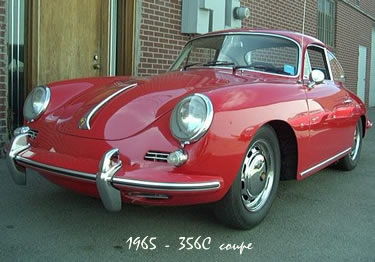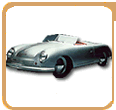|
 356 Porsche 1959
- 1965 356 Porsche 1959
- 1965 |
|
1959 Porsche 356A
By August 1958 the successor was launched to the superb but
simply equipped Speedster. The Convertible D, according to the
brochure, would deliver "the driving pleasure of the open
Roadster and the containment of the Cabriolet". For this
the new open-topped Porsche built by the Drauz company in Heilbronn
had crank-opening side windows instead of side curtains. A higher
front windscreen protected passengers with big hair from excessive
wind turbulence while driving, and the primitive seat shells
were replaced with the standard seats to make inhabitants feel
more cosseted.
The luxury Convertible was no longer available as a Carrera.
The four cam shaft master drive in the back of the Carrera versions
of the Coupé and Cabrio had increased capacity. The new
1.6 litre drive gear whose crankshaft now rotated in friction
rather than roller bearings, had also celebrated its launch
in the previous year. The de Luxe now produced 105 HP while
the GT achieved 115 HP. The lack of demand for the luxury version
showed that the Carrera clientele saw itself clearly as warrior
sports drivers.
1960 Porsche 356A
With the launch of the 356 B models at the IAA in Frankfurt
in 1959 Porsche gambled on the appeal of the A model. Porsche
made its daring leap into the 60s by giving the 356 a complete
facelift. The internally named T 5 versions therefore gained,
for instance, higher bumpers and headlights.
Ferry Porsche made it essential to make his designs foolproof
and modifications such as safety steering with hydraulic shock
absorbers, a steering wheel with lowered hub or further optimised
brakes were included to this end. The new Super 90 version also
had radial tyres and a differential spring on the rear axle
impressing all those who tested and drove them.
The Convertible D version was also renamed the Roadster for
this model year. As the first 356 the Carrera, now available
in GT version only, had a 12 volt electrical system.
1961 Porsche
The B model already launched at the end of 1959 and which had
over that time distanced itself greatly from its forbear the
VW Beetle, was carried on by Porsche into the model year 1961.
The Hardtop Coupé produced by Karmann in Osnabrück
from 1961, and now available in the new bodywork version, would
provide variety. In contrast to the Cabrio with removable hardtop,
the Karmann version with fixed welded roof was not two-coloured
but one colour – at least in the case of standard models. Until
February 1961 the Roadster was built by Drauz in Heilbronn,
then by D'Ieteren in Belgium. The Coupé and Cabrio were
produced by Reutter.
The circle of delighted Porsche owners rose steadily. In January
1961 the company celebrated the production of the 40,000th Porsche
and in one brochure from the day, one of the 40,000th customers
was quoted as saying: "There are many good cars, many good
names, but only one Porsche".
1962 Porsche 356b
The constant striving for more perfection ensured that in late
summer 1961 the 356 B matured into the model known internally
as the T 6. The notable features of this series included, for
example, a larger front and rear windscreen for the Coupé
and two air vents in the engine hood in all models. The Cabrio
driver could additionally vary the fresh air intake as the rear
window of the cover could be zipped open separately.
Numerous detail improvements were made to the always admired
metal panels, whether in the passenger area or under the engine
hood where in the 1600 S model an overhauled 75 HP engine with
grey cast iron cylinders was mounted.
On 3rd April the 50,000th Porsche was celebrated. The range
had been pared down over the year. First the Roadster and then
the Hardtop Coupé were dropped. The Karmann company began
to build Coupés along with Reutter.
The cream of the Porsche range was the Carrera 2 available from
early 1962 with a 130 HP two litre engine, "a racehorse
tamed by a master's hand" as the brochure read.
1963 Porsche 356b
The proven B model – T 6 – continued to roll off the production
line. Only two bodywork versions, the Cabrio and the Coupé,
were now produced, the latter at Reutter or Karmann.
The T 6 continued to feature striking qualities which were underlined
in a contemporary American brochure with quotes from the Playboy
author Ken W. Purdy. Purdy spoke of "absolutely astonishing
acceleration" and described the steering as being as "light
and direct as power steering without actually being power steering".
The Motor-Rundschau magazine praised the "remarkable economy
at top speeds" of the 1600 S. The article continued "even
in the harsh test drive it never exceeded 12 L/100 km".
Although the 356 B was supplied with extensive standard features,
an impressive array of extras was also available such as coconut
floor mats, an electrically operated steel sunroof from Golde
or an additional heater from Eberspächer. If you could
not fit enough luggage in the new plastic compartment under
the enlarged luggage compartment bonnet in the B model T 6,
you might be satisfied with a special luggage kit for the back.
1964 Porsche 356C
By July 1963 the final phase in the development of the 356
series had begun: the 356 C. From the outside at first glance
it was barely different from its predecessors. The wheel rims
had a different design and the identification trim on the back
was new. A C ,however, was fitted with an even more elastic
75 HP engine and a SC on a running gear with 95 HP instead of
90 HP. The Dame engine was no longer available but the superb
130 HP Carrera unit was of course still included in the range.
The running gear of the new models for its part was somewhat
more comfortable and the interior featured a new gear arrangement
on the dashboard with an additional small console.
Every C model made, except the first, was fitted with disc brakes.
This was not the Porsche design already incorporated into the
Carrera but an ATE system. The brochure particularly focused
on the new qualities: "Porsche's brakes, often called the
conscience of a car, have always been outstanding from the point
of view of dosing capability, service life and reliability.
This certainly applies to the powerful hydraulically actuated
disc brakes on all four wheels of the type 356 C".
 |
1965 Porsche 356c
There were no more major model updates of the C model, which
didn't however stop the advertising department from bringing
out lovingly produced brochures for this last production year
of the 356. "We've spent many years developing a superb
competition car so that you can have fun driving to work"
went one advertising text for the American market.
Although the Porsche 911 was already in production, the 356
still sold in surprising numbers. Around 16,684 C models were
manufactured. The final exemplar was a white Cabrio, which rolled
off the production line on the 28th April 1965. Even then, a
brief respite followed: a further ten Cabrios were built for
the Dutch Police at the start of 1966.
The end of production for the 356 had finally come, however,
while driving at its most glamorous is still possible today.
So to summarize, approximately 76,000 356s were built in Stuttgart
between 1950 and 1965. The 356B started production in 1959 and
ended in 1963 with a total number of 31, 539 cars being built
(see statistical information for
a breakdown of each type).
The 1960 model of the 356B differed in appearance from the
356A model. The bumpers were raised about four inches front
and rear and given a different shape. They also had large vertical
bumper guards. The headlights were raised up so that the fender
line was almost horizontal from the cowl to the headlight rim.
The 356B now had a horn grill above the bumper and a brake cooling
grill below the bumper, which was also where the optional fog
lights were mounted.
The 356B was the first coupe to have a front vent window like
the cabriolets had previously used. The 356B brake drums had
radial fins instead of the circumferential fins of the 356A
and earlier brakes. The transmission was changed to incorporate
a different shifter. The first 1960 356B models used a single
forward transmission mount. After 3000 cars had been built,
they reverted back to the double-mount system used with the
356A models.
The 356B series also intorduced the Super 90 version of the
car with a 90 DIN hp version of the 356 engine. This was supposed
to replace the costly Carrera model as the high performance
356. The Super 90 did perform nearly as well as the Carrera
and was far less problematic.
With the advent of the B model, the "Roadster" replaced
the Convertible D. The Roadster was essentially just a convertible
D updated to the 356B specifications. In 1961, Karmann began
production of a hard top model (also called the notchback) as
an additional model to the coupe, cabriolet and roadster versions.
The 356B was updated again in 1962 with the T6 body (previous
models referred to as the T5). The T6 was different in that
it had a squared-off front hood and the fuel -filler was moved
from under the hood to under a flap in the right front fender.
The T6 bodies also had twin engine grills for improved engine
cooling and a larger windshield and rear window. Among many
other detail changes , there was a new air vent on the cowl
to provide better ventilations.
|




